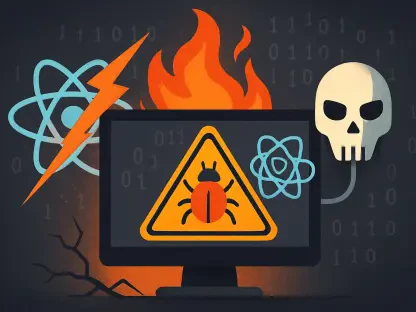In an era where cyber threats loom larger than ever, China has taken a significant step to bolster its digital defenses with the introduction of stringent cybersecurity incident reporting guidelines. On September 11, the Cyberspace Administration of China (CAC) unveiled the Administrative Measures for Reporting National Cybersecurity Incidents (AMRNCI), a framework designed to ensure swift and structured responses to cyber events that could jeopardize national security, societal stability, or economic health. These rules mandate detailed reporting protocols for network operators within and connected to China, addressing everything from notification timelines to the specific content required in incident reports. The measures reflect a growing recognition of the critical need to protect digital infrastructure against an array of threats, ranging from sophisticated cyberattacks to unintended system failures. As cyber incidents continue to evolve in complexity, understanding these new obligations is essential for any entity operating in or with ties to China’s digital landscape.
1. Understanding the Scope of Cybersecurity Incidents
A cybersecurity incident, as defined under the new Chinese regulations, encompasses any event that disrupts networks, information systems, or the data and applications they house, ultimately posing a threat to the state, society, or economy. Such incidents can arise from a variety of sources, including deliberate human actions like hacking, technical vulnerabilities in software or hardware, unexpected malfunctions, or even natural disasters. The broad definition ensures that virtually any disruption with significant impact falls under the purview of mandatory reporting. This comprehensive approach underscores the government’s intent to capture a wide range of potential risks, ensuring that no threat goes unaddressed. Network operators must be vigilant in identifying and categorizing these events to comply with the stringent guidelines set forth by the CAC, as failure to do so could result in severe repercussions.
Beyond the definition, the implications of what constitutes an incident highlight the interconnected nature of modern digital ecosystems. A single breach or failure can ripple across industries, affecting critical infrastructure, public services, and private enterprises alike. The emphasis on societal and economic impact signals a prioritization of national interests over isolated corporate concerns. For international companies operating in China, this means aligning internal incident detection and response mechanisms with these expansive criteria. Compliance requires not only technical preparedness but also a deep understanding of how an incident’s consequences are assessed under the new rules. This framework sets the stage for a proactive rather than reactive approach to cybersecurity, compelling entities to enhance their monitoring and reporting capabilities to meet national standards.
2. Reporting Obligations for Network Operators
Under the newly issued measures, network operators providing services within China bear the responsibility of reporting cybersecurity incidents to designated authorities. This obligation applies uniformly across various sectors, ensuring that any entity managing digital networks or data systems adheres to the same rigorous standards. For incidents occurring domestically, the process involves notifying the relevant competent authority promptly upon discovery of a breach or disruption. The rules are clear in their directive to prioritize transparency and speed, aiming to mitigate damage through immediate governmental awareness and intervention. This domestic focus ensures that local infrastructure remains a top priority in the face of cyber threats, with structured channels to facilitate rapid response.
Additionally, the regulations extend their reach beyond national borders when data transferred from China is affected by an incident abroad. In such cases, the Chinese entity responsible for the data transfer must report the event to the appropriate authority, ensuring that cross-border data flows do not become a vulnerability. This extraterritorial application reflects the global nature of cyber risks and the need to safeguard national interests regardless of where an incident occurs. For multinational corporations, this dual reporting requirement necessitates robust coordination between domestic and international operations to ensure compliance. The emphasis on both local and global incident reporting underscores a comprehensive strategy to protect sensitive information and maintain trust in China’s digital economy, regardless of geographic boundaries.
3. Notification Procedures and Timelines
The reporting procedures and timelines for cybersecurity incidents under the AMRNCI vary depending on the type of network operator and the severity of the incident. For Critical Information Infrastructure (CII) operators, significant or general level incidents must be reported to the competent data protection authority (DPA) and public security organ within one hour of discovery. For particularly major or major incidents, the DPA escalates the report to the CAC and the State Council’s public security organ within 30 minutes. Operators affiliated with central and state organs must notify their respective cyberspace administration within two hours for lesser incidents, with further escalation to the CAC within an hour for severe cases. Other network operators report to provincial cyberspace authorities within four hours, with similar rapid escalation for critical events. These tight deadlines emphasize the urgency of response in mitigating cyber threats.
Moreover, specific industries with additional regulatory frameworks must also report to their respective industrial authorities, ensuring sector-specific oversight. If an incident involves criminal or illegal activities, public security authorities must be informed promptly, adding another layer of compliance. These structured timelines and multi-tiered reporting obligations aim to create a seamless flow of information to the appropriate bodies, enabling swift governmental action. Network operators must establish internal protocols to meet these deadlines, as delays can exacerbate the impact of an incident. The detailed differentiation based on operator type and incident level reflects a tailored approach, recognizing that not all entities or events pose the same level of risk. Compliance with these procedures is not just a legal mandate but a critical component of national cybersecurity resilience.
4. Essential Content for Incident Notifications
When submitting notifications to regulators, network operators must include a comprehensive set of details to ensure authorities have a clear picture of the incident. This includes the name of the affected entity and specifics about the impacted system, alongside the time, location, type, and severity of the event. The report must also outline the incident’s impact, harm caused, and initial remedial measures taken, with additional specifics like ransom details in cases of ransomware attacks. Further, operators need to describe the ongoing development of the situation, potential future impacts, preliminary causes, and early investigation findings, including attacker information and system vulnerabilities. Proposed additional measures, coordination with authorities, evidence preservation status, and other relevant details must also be provided to complete the notification.
If the full scope of information cannot be compiled within the stringent reporting timelines, the initial report may focus on the entity’s name and basic incident details, with supplementary data submitted as it becomes available. Additionally, any significant updates or new developments related to the incident or investigation require prompt supplementary notifications. This flexibility acknowledges the chaotic nature of cyber incidents, where complete information may not be immediately accessible. However, the expectation of thoroughness remains, compelling operators to prioritize rapid data collection and analysis. Such detailed reporting ensures that authorities can assess the situation accurately and coordinate effective responses, minimizing damage and preventing recurrence. The emphasis on continuous updates further enhances situational awareness for all stakeholders involved.
5. Summary Reporting After Incident Resolution
Following the resolution of a cybersecurity incident, network operators are required to conduct a detailed analysis and submit a comprehensive summary report within 30 days. This report must cover the root cause of the incident, the remedial actions implemented, the extent of harm caused, and the identity of any threat actors involved. Additionally, it should outline corrective steps taken to prevent future occurrences and lessons learned from the event. The submission must be made through the same channel used for the initial notification, ensuring continuity in communication with authorities. This post-incident requirement emphasizes accountability and the importance of learning from each event to strengthen future defenses against cyber threats.
The summary reporting process serves as a critical tool for both operators and regulators to evaluate the effectiveness of response strategies and identify systemic weaknesses. By documenting the full lifecycle of an incident, from occurrence to resolution, entities can refine their cybersecurity posture and contribute to broader national efforts to enhance digital security. This requirement also facilitates a feedback loop, where insights gained from one incident can inform preventive measures across industries. For regulators, these summaries provide valuable data to assess trends in cyber threats and adjust policies accordingly. The focus on detailed post-event analysis reflects a forward-thinking approach, aiming to transform individual incidents into opportunities for systemic improvement in cybersecurity resilience.
6. Available Channels for Incident Reporting
To facilitate the reporting of cybersecurity incidents, the CAC has established multiple accessible channels for network operators to submit notifications. These include a dedicated hotline number, “12387,” for immediate contact, as well as an official website, cert.org.cn, for online submissions. Operators can also use the “12387” mini-program on WeChat or the “National Internet Emergency Center CNCERT” WeChat official account by selecting the “Report Incident” option. For those preferring written communication, reports can be sent via email to [email protected] or faxed to 010-82992387. This variety of options ensures that entities of all sizes and technological capabilities can comply with reporting requirements without undue burden, streamlining the process of alerting authorities to cyber threats.
The availability of multiple reporting channels reflects an understanding of the diverse operational environments in which network operators function. By offering both digital and traditional methods, the CAC aims to remove barriers to compliance, ensuring that even smaller entities or those with limited technological infrastructure can meet their obligations. This accessibility is crucial during the critical early stages of an incident when every minute counts in mitigating damage. Furthermore, the use of widely recognized platforms like WeChat demonstrates an adaptation to modern communication trends, making reporting more intuitive for users. These channels collectively create a robust framework for incident notification, ensuring that authorities receive timely information to coordinate effective responses and protect national digital interests.
7. Penalties and Mitigation for Non-Compliance
Failure to adhere to the reporting requirements outlined in the AMRNCI can result in significant penalties for network operators. Regulatory authorities have the power to impose sanctions on entities that do not report incidents within the stipulated timelines or fail to provide accurate information. Moreover, if delayed, incomplete, false, or concealed reporting leads to substantial harm, both the operator and responsible personnel may face even harsher consequences. This strict enforcement underscores the critical importance of transparency and timeliness in addressing cybersecurity incidents, as lapses can exacerbate damage to national security and economic stability. The potential for severe penalties serves as a strong deterrent against negligence or willful non-compliance.
However, there are provisions for mitigating or even avoiding penalties under certain conditions. If a network operator can demonstrate that reasonable and necessary security measures were in place, that an effective incident response plan was followed, and that the impact and harm of the incident were minimized through prompt action, lighter penalties or exemptions may apply. Compliance with the AMRNCI’s reporting guidelines is a key factor in such determinations, highlighting the value of preparedness and adherence to protocol. This balanced approach incentivizes proactive cybersecurity practices while holding entities accountable for failures. For operators, investing in robust security frameworks and training can thus serve as both a protective measure against cyber threats and a safeguard against regulatory repercussions.
8. Looking Ahead: Building Resilience Through Compliance
Reflecting on the implementation of these cybersecurity reporting rules, it becomes evident that China has set a precedent for rigorous digital oversight. The structured timelines, detailed content requirements, and multiple reporting channels establish a clear pathway for managing cyber incidents effectively. Network operators navigate the complexities of compliance, balancing rapid response with comprehensive documentation to meet governmental expectations. The penalties for non-compliance act as a powerful motivator, while provisions for mitigation encourage the adoption of strong security practices. This framework not only addresses immediate threats but also lays the groundwork for long-term improvements in national cybersecurity.
Moving forward, entities operating within or connected to China’s digital ecosystem should prioritize integrating these reporting obligations into their operational strategies. Developing robust incident detection systems, training staff on AMRNCI requirements, and establishing clear internal reporting protocols are essential steps to ensure compliance. Additionally, leveraging the post-incident summary process to refine cybersecurity measures can turn challenges into opportunities for growth. Collaboration with authorities through the provided channels will be crucial in maintaining transparency and trust. As cyber threats evolve, staying ahead of regulatory expectations through proactive preparation will be key to safeguarding data and infrastructure in an increasingly interconnected world.









